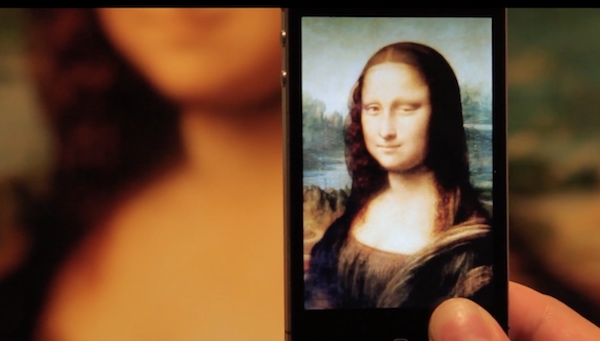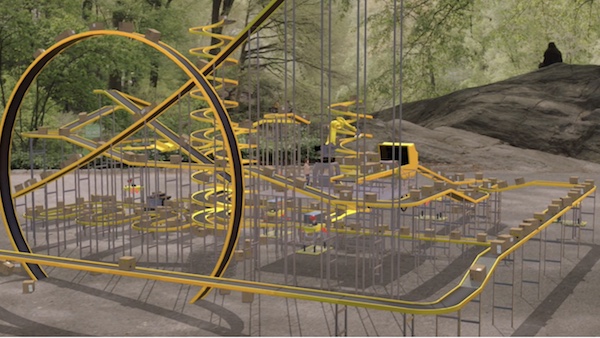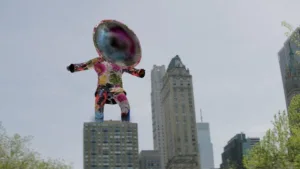For quite some time we have seen many installations where AR as in augmented reality is used to create images and information where there is none to begin with. We all have seen the ideas of improving map apps with local info like menus for restaurants and offers from local stores. All these applications are business-based and more of an information or marketing approach then anything else.

AR as art has been available for several years already. Basically all these AR-art apps create images that are triggered by viewing any kind of object that is used as the avatar of the respective works of art. In general any object could trigger the art object to appear. In the beginning, many installations focused on inside objects that when viewed through the camera of a mobile device showed a piece of video or other images complementing the original piece of art.
These kind of installations are typically in a museum or an art gallery using specific apps you have to download to your mobile device. One of these apps is, for example, ARART, an app developed in Japan and available on the Apple App Store. They can animate a painting (like the Mona Lisa winking at you), illustrate a novel or provide some feedback of various media like visual and audio effects depending on what you are looking at. This was, and still is, mostly aimed at users with mobile devices. AR glasses were not necessarily needed for this experience. Furthermore, since most visual artists are very particular about the colors used in their art, the better the display quality, the closer the viewer will get to the experience the artist wanted to create. Otherwise this is like watching a Rembrandt on a CGA display (not very likely that you still have one, but you get the point).
 ARART app showing Mona Lisa
ARART app showing Mona Lisa
The other question is whether a winking Mona Lisa is actually an improvement to the original painting. This kind of question is, of course, as old as modern art and certainly can’t be answered in this article. This is entirely up to the viewer. In a more general view, I would say that art is a kind of entertainment and these installations would certainly qualify as entertainment at the least.
ARTIVIVE is doing the same thing, possibly on a little larger scale. Their motto is “Bring art to Life”, a good description of what they are doing. This is at least a surprising event when viewed for the first time, but maybe not a real AR-based art form.
About a year ago Adobe introduced AERO as the AR platform for artists. Their goal was to get artist interested in creating real art in AR. Not an extension of existing art but standalone works of art. There will be great pieces and not so great pieces, just as with every other art form. For every great piece of art there are millions not so great ones. As mentioned above, this is all in the eye of the beholder.
This week Apple announced [AR]T as a form where art appears in the outside world. Still based on mobile devices, a skyscraper may just show you a man with a giant loudspeaker as a head on top of a sky scraper. If this is not bizarre for you, how about running conveyor belts in the park? All of these can be experienced on the [AR]T Walk tour put together by Apple.
Apple [AR]T – Nick Cave’s Soundsuits
It is not clear how far the Adobe’s artist call contributed to these art installations. Remember when Christo created “Surrounded Islands” by dressing up some islands in Florida with pink skirts? [AR]T will make this much easier and cheaper of course. Apple worked with the New Museum in New York City to create walking tours through the city where the participants can experience several pieces of art. The featured artists are Nick Cave, Nathalie Djurberg, Hans Berg, Cao Fei, Carsten Höller, Pipilotti Rist and John Giorno, all selected by the New Museum.
 Apple [AR]T – Cao Fei’s Trade Eden
Apple [AR]T – Cao Fei’s Trade Eden
Apple will bring this walking tour to San Francisco, New York, London, Paris, Hong Kong and Tokyo. The art creations will appear on an AR-enabled iPhone and will also include audio. Participants need to sign up, but just in case you want to come to New York for the [AR]T Walk, all the spots are already taken. The best you can do is to go to the ‘Today at Apple’ website and look at what you are missing out on.
There is no question in my mind that AR is a new medium that could lead to pieces of art. So to speak, AR art is real computer art that only exists as a bitstream translated by the mobile display to become visible to the human eye. And here is where the issue lies for me. AR or augmented reality relies on the visibility of the real life environment with an overlay of the augmented part. Using an AR headset would lead to an issue of background illumination with the artist’s vision of his art work. How do you see an ART art piece during night versus during full sunlight? The artist needs to consider all illumination possibilities as well as the used AR hardware. Using a headset, the art work should fall completely inside of the field of vision to allow for a full experience. In a certain way a VR headset maybe even providing a better quality rendering as the brightness and colors can be better controlled. This is one the reasons that most AR art installations are using mobile displays, no background noise, so to speak.
Nevertheless, I am looking forward to see some of this new art form in the future. Art was always a developing discipline, where artists pushed the boundaries of what was acceptable by the viewers. This goes for DaVinci in the same as it was for Picasso or Dali. Remember Dali’s venture in making movies as an extension of his art? Since then we have accepted movies as a legitimate art form (okay not all of the movies), but we have to accept AR art in the same way. – NH

